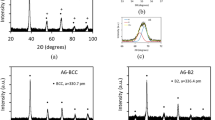Conclusions
-
1.
The dissolution of the excess Laves phase in alloy 36NKhTYuM8 under the conditions of rapid quenching is maximum in the stage of heating to 1200°C, and the efficiency of the treatment increases in proportion to the heating rate. We have suggested an explanation of the determining role of the heating rate in the dissolution of the excess phase, which is based on the concept of high thermal stresses that appear on the interphase boundaries because of the difference in the coefficients of thermal expansion of the matrix and the phase.
-
2.
High plastic deformation of alloy 36NKhTYuM8 (ε=70%) is accompanied by deformation and cracking of the particles of the excess Laves phase, but the nonequilibrium nature of the structure of these particles does not influence noticeably their solubility under the conditions of rapid heating.
-
3.
The process of primary recrystallization that occurs in deformed alloy in the stage of rapid heating does not stimulate the dissolution of the excess phase, which means that the efficiency of rapid heating in quenching of alloys can be used independently of their initial state.
Similar content being viewed by others
References
G. M. Klykov, A. G. Rakhshtadt, O. M. Khovova, and V. A. Uzakova, “Effect of quenching regimes with the use of electric contact heating on the structure and properties of spring alloy 36NKhTYu,”Metalloved. Term. Obrab. Met., No. 7, 15–18 (1991).
A. G. Rakhshtadt, O. M. Zhigalina, O. M. Khovova, and G. M. Klykov, “Special features of formation of the structure of dispersion-hardening alloy 36NKhTYu with a mixed mechanism of segregation of the hardening phase under quenching from rapid electric contact heating,”Fiz. Met. Metalloved.,81(5), 140–149 (1996).
A. G. Rakhshtadt, O. M. Khovova, and O. M. Zhigalina, “A study of the structure and properties of dispersion-hardening spring alloy 36NKhtYuM8 after rapid quenching,”Metalloved. Term. Obrab. Met., No. 5, 2–7 (1996).
O. M. Khovova, O. M. Zhigalina, and I. O. Dumanskii, “Effect of the rate of electric contact heating on the structural state of alloy 36NkhTYuM8,”Metalloved. Term. Obrab. Met., No. 9, 16–20 (1998).
A. G. Rakhshtadt,Spring Steels and Alloys [in Russian], Metallurgiya, Moscow (1982).
S. A. Saltykov,Stereometric Metallography [in Russian], Metallurgiya, Moscow (1970).
S. S. Gorelil,Recrystallization of Metals and Alloys [in Russian], Metallurgiya, Moscow (1978).
V. I. Ivanov and K. A. Osipov,Recovery and Recrystallization in Metals under Rapid Heating [in Russian], Nauka, Moscow (1964).
B. V. Molotilov (ed.),Precision Alloys, A Handbook [in Russian], Metallurgiya, Moscow (1983).
J. Hearth and I. Lote,The Theory of Dislocations [Russian translation], Atomizdat, Moscow (1972).
I. S. Grigor'ev and E. Z. Meilikov (eds.),Physical Quantities, A Handbook [in Russian], Énergoatomizdat, Moscow (1991).
Author information
Authors and Affiliations
Additional information
Translated from Metallovedenie i Termicheskaya Obrabotka Metallov, No. 6, pp. 13–19, June, 2000.
Rights and permissions
About this article
Cite this article
Khovova, O.M., Zhigalina, O.M., Dumanskii, I.O. et al. Special features of dissolution of the laves phase under the conditions of rapid electron heating for quenching. Met Sci Heat Treat 42, 214–220 (2000). https://doi.org/10.1007/BF02471314
Issue Date:
DOI: https://doi.org/10.1007/BF02471314




